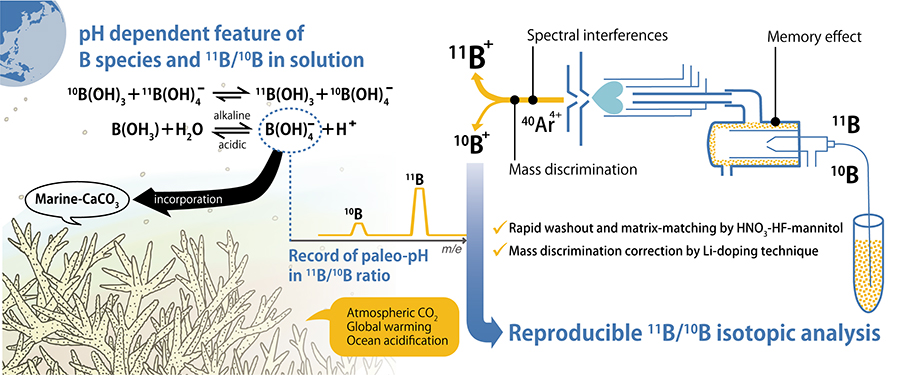- 著者
- Masaharu TANIMIZU Kazuya NAGAISHI Tsuyoshi ISHIKAWA
- 出版者
- The Japan Society for Analytical Chemistry
- 雑誌
- Analytical Sciences (ISSN:09106340)
- 巻号頁・発行日
- vol.34, no.6, pp.667-674, 2018-06-10 (Released:2018-06-10)
- 参考文献数
- 29
- 被引用文献数
- 13 13
We developed a method for rapid and precise determination of B isotope ratios by MC-ICP-MS through an optimization of washout method, mass-discrimination correction and chemical separation. Resultant reproducibility of δ11B values was ±0.4‰ (2 × SD) when a simple standard-sample bracketing technique was used, and it was improved to be better than ±0.2‰ by a mass discrimination correction with a 7Li/6Li isotopic reference. A mixed solution, which consists of HNO3–HF–mannitol, allowed a rapid washout of B memory in the sample introduction line. The validation of this technique to a wide range of δ11B value and various B signal intensities was confirmed from a series of B reference solutions with δ11B values of –20 to +40‰ and 25 to 125 ng/g B. Analyses of seawater standard (BCR-403) and carbonate standard (JCp-1) with sample sizes of less than 50 ng B gave δ11B values consistent with those determined by TIMS as Cs2BO2+. The simple and high-precision technique developed here is applicable to various types of commercially supplied multiple collector ICP mass spectrometers without any modification of the sample introduction system from their original instrumental setting.
- 著者
- Rofiqul Umam Masaharu Tanimizu Hitomi Nakamura Yoshiro Nishio Ryo Nakai Naoto Sugimoto Yasunori Mori Yuuki Kobayashi Akane Ito Shigeyuki Wakaki Kazuya Nagaishi Tsuyoshi Ishikawa
- 出版者
- GEOCHEMICAL SOCIETY OF JAPAN
- 雑誌
- GEOCHEMICAL JOURNAL (ISSN:00167002)
- 巻号頁・発行日
- vol.56, no.5, pp.e8-e17, 2022 (Released:2022-10-18)
- 参考文献数
- 28
- 被引用文献数
- 3
Slab-dehydrated fluid is considered to be involved in island arc magmatism. In this study, Li isotope ratios were determined for deep groundwater samples from the non-volcanic forearc region of SW Japan. The contribution of the slab-dehydrated fluid from the Philippine Sea Plate (PHS) was investigated in the Arima area and the eastern Kii Peninsula area, corresponding to the slab depths of ~60 km and 20–30 km, respectively. In the Arima area, the high-temperature thermal waters with high salinity called the Arima-type fluid were clarified to have low δ7Li values of +1–+3‰. The low δ7Li values with high Li concentrations are thought to be the result of fluid-rock interactions at high temperatures, which is consistent with the characteristics of the slab-dehydrated fluid. On the other hand, the δ7Li values of deep groundwaters in the eastern Kii Peninsula showed a wide range of +2 to +29‰. Several groundwater samples had a similar chemical property to the Arima-type fluid: low δ7Li values, low Cl/Li ratios, and 87Sr/86Sr ratios around 0.708–0.710. They are distributed along the Median Tectonic Line (MTL) and within about 20 km south of the MTL. These results indicate a common supply of slab-dehydrated fluids to the non-volcanic forearc region in SW Japan from PHS along the large faults, and Li isotope ratios will be a useful indicator to detect their contribution.
- 著者
- Teruyoshi IMAOKA Jun–Ichi KIMURA Qing CHANG Tsuyoshi ISHIKAWA Mariko NAGASHIMA Natsuki TAKESHITA
- 出版者
- Japan Association of Mineralogical Sciences
- 雑誌
- Journal of Mineralogical and Petrological Sciences (ISSN:13456296)
- 巻号頁・発行日
- pp.200721, (Released:2021-02-10)
- 被引用文献数
- 4
We report in situ major and trace element and Li isotope analyses of murakamiite and Li–rich pectolite in an albitite and whole–rock analyses of the albitite and host granite from Iwagi Islet, SW Japan. The albitite forms small bodies that are several tens of centimeters to tens of meters in size, disseminated in a host granite of Late Cretaceous age. The studied murakamiite–bearing albitite contains albite, sugilite, aegirine–augite, quartz, murakamiite–Li–rich pectolite, microcline, katayamalite, and accessory minerals. It shows conspicuous strain–induced textures. The murakamiite and Li–rich pectolite form a solid solution with Li × 100/(Li + Na) atomic ratios ranging from 44.2 to 60.1, and the Na line profiles show a zoning structure in which Na decreases from core to rim. Major and trace element compositions of murakamiite–pectolite normalized to that of albitite indicate the enrichments of some elements, particularly in Mn, Ca, Li, Sr, and REEs, roughly on the same order of magnitude (~ 10 times). The albitite–normalized element concentrations vary systematically with ionic radius of the element; the normalized concentrations of cations with the same valence roughly form a simple convex parabolic curve when plot against the ionic radius. This indicates that the element partitioning of murakamiite and pectolite during metasomatism to form albitite took place under a strong control of crystal structure, quasi–equilibrated with metasomatic fluids and coexisting minerals. The δ7Li values of murakamiite and Li–rich pectolite show a wide range from −9.1 to +0.4‰ (average −2.9‰), and no obvious correlation with Li contents was observed. These δ7Li values should have resulted from hydrothermal fluid–rock interactions at the temperatures of 300–600 °C. The very low δ7Li values down to −9.1‰ may have originated from intra–crystalline Li isotope diffusion, or involvement of deep–seated, Li–Na–enriched subduction–zone fluids with low δ7Li values.
